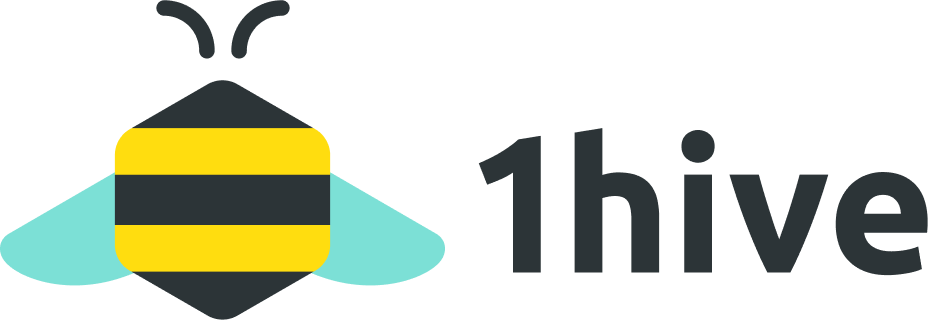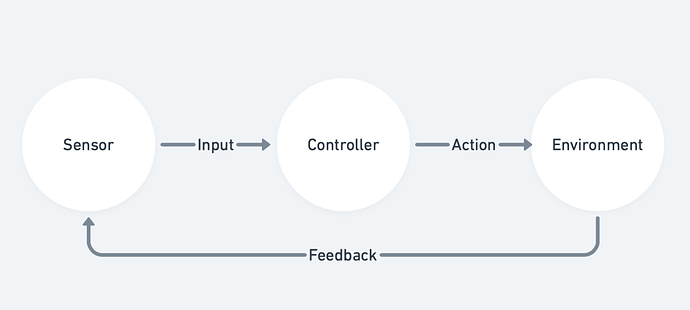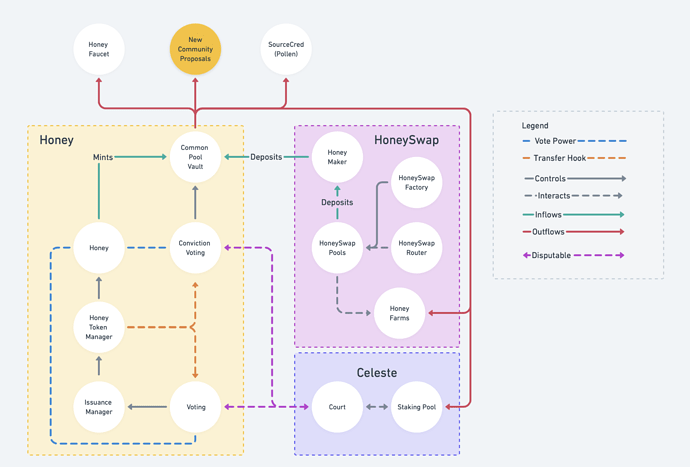1hive is a decentralized autonomous organization, but that doesn’t really mean very much to very many people, and even for people that are familiar with DAOs, the term has been used in so many different context that it has lost much of its meaning.
The following is one attempt to characterize what 1hive is, perhaps other will have different perspectives…
1hive is a cybernetic superorganism, conviction voting is its brain, honey is its lifeblood, celeste is its spirit, and we are all its cells.
Will get into each of those statements in more detail bellow, so don’t be too concerned if you found it a bit nonsensical.
:: a cybernetic superorganism
a cybernetic superorganism
At a basic level a cybernetic system has a closed signaling loop, where action by the system generates some change in the environment and that change feeds back as input into the system.
In the case of 1hive, honey holders act as sensors by evaluating the environment and choosing to take action by buying, selling, or signaling their preferences for how the system should behave by staking on proposals. When proposals pass their effect may alter the environment, for example topping up the faucet may attract more new contributors and raise awareness of 1hive, where funding a farm may attract additional liquidity to a given honeyswap pair. Each individual will judge how proposals have impacted the environment, assess their individual goals, and then take further actions as a result, creating a cybernetic feedback loop.
Because honey holders act as individuals within the system, acting based on their own inputs and producing outputs that in aggregate create more complex emergent behavior, we can understand the system as a whole as being a form of superorganism, similar to a hive or even a city. Superorganisms exhibit some degree of coherent collective intelligence, even though the constituents decision making processes don’t require reaching consensus as a whole.
Unlike a company, which may act as a single entity that is capable of making decisions as a unit and giving orders in a top down fashion, 1hive is structured such that collective decisions are the emergent result of individual actions. While we do have some limited ability to vote on administrative decisions as needed, this functionality has been made purposely difficult and intended to be used only rarely.
The following is a more detailed view of 1hive, we can use it to see how honey flows, how signals are processed, and how feedback loops form. It includes an important sub system, Celeste, that has yet to launch. And should not be considered exhaustive because new community proposals can result in the creation of entirely new sub systems over time.
:: conviction is its brain
conviction is its brain
Humans are also cybernetic superorganisms, made up of trillions of individual cells, each responding to inputs and creating outputs that enable the emergence of collective intelligence. Our brain, made up of a subset of cells helps to aggregate information from all of the cells and synthesizes those inputs into actions in order to respond and adapt to changes in our environment.
The conviction voting mechanism serves this purposes in 1hive, and its worth going into some detail as to how it works because it is quite a bit different than what most people associate conceptually with the idea of voting.
Conviction Voting regulates honey outflows based on a combination of stake and time, serving as both a way to proportionally represent signals in output actions as well as budget resource expenditures over time.
Unlike a traditional voting model, all proposals are considered “on the table” simultaneously. To support a proposal, you must stake some amount of honey behind a proposal, while staked you cannot use the same honey to support any other proposals, and if you transfer the honey you have staked your support will automatically be removed from the proposal.
By staking to a proposal you are signaling that you want the proposal to pass, however, the signal doesn’t take just the balance that is staked, but also the time that it has been staked. In other words its not sufficient to simply stake to a proposal and then immediately change your support, to maximize your influence you have to stake and let your conviction for that proposal build up over time.
This has some really interesting properties:
- People have to hold honey over time in order to influence how honey flows, so by supporting a proposal people are exposed to the price changes associated with broadcasting their support.
- Honey can only be used to support one proposal at a time, so proposals are inherently competing for the support of honey holders.
For each proposal that requests honey from the common pool there is an associated activation threshold expressed as a proportion of total conviction available in the system that must be achieved. This means that requesting a small amount of the common pool will require less conviction than requesting a larger amount, and that proposals will require less overall conviction when there is less honey actively being used to stake on proposals overall.
And once again this introduces some interesting properties:
- The rate at which conviction accrues determines a maximum rate at which honey can leave the common pool.
- Activating honey to support the “abstain” or other signaling proposals increases the amount of honey required to pass funding proposals and slows down the rate at which honey can leave the common pool.
Coming back to the brain analogy, we can think of individuals as cells responding to external stimulus, each processes the stimulus using their own internal model of the environment, and then broadcasts their preferences accordingly. They can signal for specific actions or speed up or slow down rate of actions. Conviction voting fuses these preference signals into collective action through the distribution of honey, similar to how neurons firing in the brain fuse sensory inputs to produce actions in the human body.
We are more sophisticated sensors than single cells. We have higher fidelity models of our environment and produce much more strategic preferences as outputs. But by adopting a decentralized bottom-up architecture, where sensors act independently, and coordinate together according to a protocol, we can achieve greater social scalability, throughput, and resilience than if we needed to produce and reach global consensus for each and every possible action.
To dig deeper on conviction voting and how it works, check out our extensive cadCAD model.
:: honey is its lifeblood
honey is its lifeblood
One thing everyone in the community can agree on is that we want honey to be valuable, furthermore if we want 1hive to grow sustainably we need it to be valuable.
We need it to be valuable because we need to be able to motivate contributors to contribute in exchange for honey. If there are no contributors willing to contribute, 1hive will stagnate. It’s honey that gives 1hive life. If honey stops being valuable, or stops circulating through the 1hive economy, 1hive will almost certainly die.
If we are constantly distributing honey to contributors, that honey needs to come from somewhere.
Issuance is one source, but it is effectively a tax on honey holders, which may be fine from a value perspective so long as the proceeds result in sufficient growth in the honey economy, but issuance is certainly not desirable.
Rather than issuance, we could also create mechanisms like the honeyswap maintainer fee share, convert the fee revenue to honey, and then deposit that honey into the common pool so it can be recirculated to future contributors.
Ideally we would blend these two options so that we can ensure that there is always a specific percentage of the supply that is flowing through the common pool while keeping issuance to the minimum necessary to achieve that goal.
This way we help encourage holders to allocate issuance towards things which are likely to recapture and recirculate honey, or to things which lock up honey and offset the effects of issuance, but either way we always ensure that honey is flowing consistently.
In practice 1hive’s current issuance policy is naive and must be adjusted via administrative governance, but it can and likely will be improved and automated in the future. It’s one of the things I would like to work with the recently formed Luna Swarm on in the near future.
:: celeste is its spirit
celeste is its spirit
While there is an implicit objective to make honey valuable, because you need to hold honey to influence the direction of the protocol, and if you hold honey you naturally would prefer it to be more valuable than not, the lack of a clear intention beyond profit makes me nervous.
I think we would all be more comfortable, more confident, and sleep a bit easier if we we could encode our goals, intentions, culture, and values into the autonomous entity we are unleashing on the world.
Celeste is how we do that. Celeste is a subjective oracle protocol, it allows a smart contract to ask subjective questions and receive answers on-chain. This enables a smart contract system, to define interaction rules in human language, and invoke Celeste in the event that there is a dispute over whether those rules have been followed.
In our case this will enable 1hive to encode the community covenant into the proposal process, so that proposals which are deemed to violate the covenant can be blocked. We will also be able to use it to introduce greater accountability in proposals, with escrow, milestones, or payments tied to impact. We could even use it to settle prediction markets.
Celeste is based on the Aragon Court code base, it works similarly but has been modified to use honey as its staking token and to limit the amount an individual is eligible to stake using brightid. This will help ensure the integrity and legitimacy of Celeste’s ability to encode human values into its responses, and help reduce the gini coefficient of the honey distribution.
Its looking like we may be able deploy Celeste and upgrade conviction voting to support invoking Celeste before the end of the year. Major shoutout to Fiore, Rodri, Fabri, and especially Will for their efforts to make that possible.
:: and we are all its cells
and we are all its cells
1hive is nothing without us, just like a bee hive is nothing without bees.
We are building a community first and foremost, the tools, technologies, and institutions which we create along the way are not a goal in and of themselves but rather are in service to the communities health and well being.
We are not married to any technology, just as bees might abandon a hive that no longer serves them and swarm to find a new home. We’ve moved from Rinkeby, to Ethereum, to xDai already. If we stick together as a community, we can build whatever and wherever is necessary to make 1hive thrive. Its not the technology, its the community.
We are all 1hive, together we thrive.







